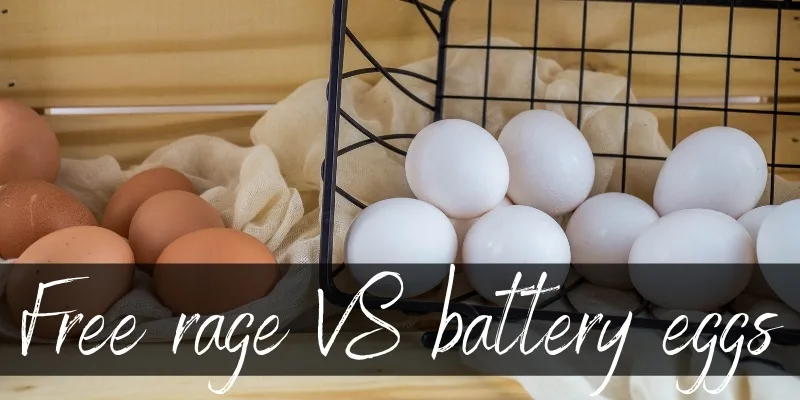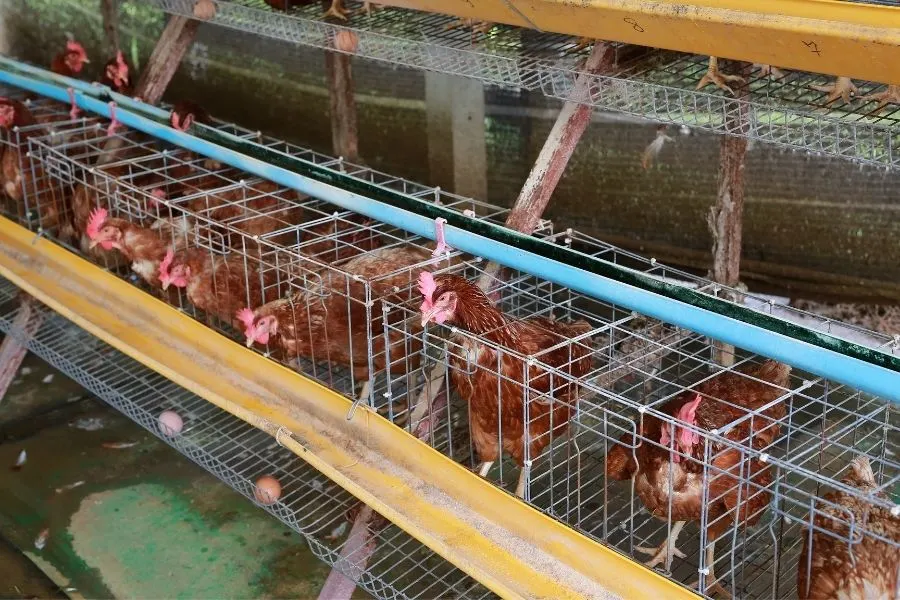Even been in the supermarket and wondered just what kind of eggs to get ? Doe it even matter, aren’t they all the same ? Nowadays we have so many options when it comes to eggs we get overwhelmed.
Two options stand out though. Battery eggs and free range eggs, from the cheapest to the most expensive. There has to be a clear difference, despite both being just eggs.
Today we’re going to crack this mystery and see what each of them means, and what the main differences are.

Disclaimer: we’re not advocating for battery eggs or inhumane animal treatment. We’re simply presenting the facts in this article. If you’re vegetarian, vegan, or very passionate about animal rights this post may upset you, as it will explain the way chickens are kept for commercial egg farming. Very little of it is pleasant to read.
Battery VS free range eggs
The main differences between battery and free range eggs is the way the hens are kept. Battery eggs come from hens kept in wire cages, in several long rows on top of another.
Free range eggs come from hens that don’t have their movement restricted, may have access to outside areas, and are generally less stressed.
There is a nutritional difference between free range eggs and battery eggs. Battery eggs are a little less nutritious, while free range eggs are more nutrient-dense.
Both types can be equally old or fresh, and the bottom line seems to be what matters the most for producers and retailers.
By this we mean that battery eggs are more profitable for producers and farmers, since more hens can lay more eggs. Free range eggs are less profitable compared to battery ones, due to lower yield and higher rate of broken or missing eggs.
We’ll get to explaining all of these differences in much more detail below, and clarify what each of them means. But first we need to understand what an egg is, and why a hen lays eggs. This will help explain a lot of the reasoning behind battery eggs, and why they’re so common.
How eggs work and why hens lay them
First off, what is an egg ? You know what it looks like, but what is an egg ? As gross as some people may think it is, the eggs is just a chicken’s equivalent of a human embryo.
Originally hens used to produce up to 12 embryos, that would be fertilized by the male (rooster). This would stop as the cold season approached, so the only new brood would be in spring.
Over time humans noticed that when a hen’s egg would be taken away, she’d lay a new one to get to that 12 egg clutch. Even if the egg wasn’t fertilized, the hen would still lay it.
Those are the eggs that we can safely eat, the ones that aren’t fertilized. The only time a hen’s egg grows into a chick is when a rooster is let into the room to impregnate all the hens.
As time went on and humans figured out how to trick hens into laying eggs every few days, they also selectively bred the most prolific egg layers. Today there are breeds that can lay up 300 eggs a year.
The downside to this is that the hens lose a lot of minerals and vitamins when laying an egg, so their lifespan is reduced by more than half.
Nowadays hens can safely produce eggs for about 12 months, after which their health rapidly decreases due to nutrient loss. Those hens are then slaughtered and sold as soup chicken, or just older chickens.
As unfair as all of this sounds, that’s the process most chickens go through. So let’s see the difference between battery and free range eggs, and if any of them are treated better.
Read also: What Do Raw Eggs Taste Like ?
What are battery eggs ?
Battery eggs come from chickens that are raised in the above mentioned conditions. The chickens are reared in wire cages that are suspended from the floor, in long rows. Several chickens are kept in a single cage, and there are up to 4 rows on top of each other.

When the hen lays her egg, the egg rolls down a slope into a long trough. The eggs are then collected, inspected, packaged and sold as battery eggs.
This is the lowest comfort for the chicken, and the highest-profit method. As long as the hen doesn’t see an egg, she will produce one.
What are free range eggs ?
Free range eggs are (in theory) the opposite of battery eggs. The hens are allowed outside of their cages or not kept in cages at all. They can roam outside and have plenty of movement (pastured eggs, do not confuse with pasteurized eggs).
There are less chickens per square foot, and they can retreat to their nests at any time. Since chickens seem to develop a preference for where they lay their eggs, they will almost always choose the nest to lay them.
The eggs are then taken from the nest, inspected, packaged and sold.

Very poor legislation for what free range means
‘Free range’ is very poorly legislated and can mean different things in different countries. In some places it means the hens are allowed outside all day to roam, in others the hens are confined to a barn but not in cages, and in others it means the cages are always open and the hens can move about as they like.
In short, there was a ban in 1999 in the European Union, that prevented farmers from using battery cages. However there was a 13 year phase-out, and it does not apply to all farms. Those that have less than 350 laying hens, or those farms that rear laying hens do not have to comply.
Even today there are many workarounds for battery cages, as this kind of egg farming is still the most profitable (high yield).
Are happy eggs really free range ?
Yes, ‘happy eggs’ or eggs from ‘happy chickens’ are free range. The level of freedom of those chickens varies from farm to farm, but they’re generally much more free to move around than battery chickens.
Yolk color is easy to trick
You may think that the color of the yolk is a great indicator for the nutritional value or quality of the egg. It’s true that it’s correlated, in that deep yellow-orange yolks are usually found in free range eggs, but it’s not causal.
The color of the yolk can be tricked by feeding the chickens foods high in beta-carotene. So bell pepper extract, carrot extract, paprika can all be mixed into the chicken feed to get an orange yolk. This means you can easily find battery eggs with orange yolks and it will mean nothing.
Alright. We’ve explained battery eggs, free range eggs, and how dodgy the legislation can be with the latter. Now let’s make a quick comparison between them to really understand the differences.

Space for the hens to roam
Battery hens have very little room to roam. Their movement is restricted to their cages, and there are 3-5 hens in a cage. Hens are easier to keep track of and there is less aggression or cannibalism between the birds in batteries.
When an eggs is laid, it rolls away from the hen. This makes sure there are almost zero broken eggs. Hens may break or kick eggs by mistake when roaming, while battery hens can’t reach their eggs after laying them.
In contract a free range hen can leave her nest or cage, and move around the barn or yard. Sometimes the birds are allowed free access in and out of the barn and yard, sometimes it’s restricted.
There is the danger or predatory birds or foxes when raising hens this way. Not all farms are equipped with wire fences on the top, and a very sturdy fence out the outside to keep predators away.
The food is the same for both
Both chickens are fed the same. Commercial chicken feed is what both eat, so their nutritional intake doesn’t change significantly. There are levels above free range, where the what and how of chicken feed is strictly regulated.
For example organic, free range organic, and pastured eggs all have progressively better feed that doesn’t contain animal byproducts like ground fish bones.
Does free range have that in their chicken feed ? They might. There’s not regulation to check for that.
Nutritional content difference
Then there is the nutritional content of the eggs. Battery eggs are laid more often than free range eggs. The hens can’t move that much and are crowded together.
This results in a stressed, tired hen and the overall result is a poor egg, but it can still be sold.
Free range eggs have more movement and are laid a little less often than battery eggs. The hen is less stressed, though even here there are some dominant hens that bully the smaller ones.
Buildingourrez has an amazingly in-depth article on the nutritional data for each egg type. From caged to pasture raised, he takes a look at how each farming method works and how it affects the final egg.
The gist of it is that saturated fats and cholesterol were highest in caged eggs. The hens are sedentary and this reflects in the egg. Vitamins and minerals like vitamin A, D, E, B5, B12, zinc and selenium were much higher in free range, organic, and pasture raised eggs.
Read Also:Pumpkin Substitute For Eggs
Profit VS humane treatment
In the end the whole thing comes down to the profit farmers and producers make off the hens, and the humane treatment of the animals.
Humans have been rearing domestic animals for millennia, and balancing profit with adequate housing and treatment of animals was always an issue.
On one hand, you have those who are looking for profit. Those who raise chickens as their livelihood, and a good portion of them are actual industrial producers. Not many are cute farmers with weaved baskets going to collect a few eggs from their happy chickens.
Those people will always keep an eye on their profit margin, and will only take into account the hen’s happiness if it impacts their profit. There are plenty of watchdog organizations that look out for farm chickens, and do their best to change legislation to protect them.
What we can do as consumers is support the free range, organic, and pasture raised companies, to drive demand in that area.
A better option would be to buy locally, from neighboring farmers. Those eggs will always be fresh, and you can check in to see the farm at any time if it’s nearby.

